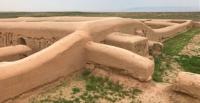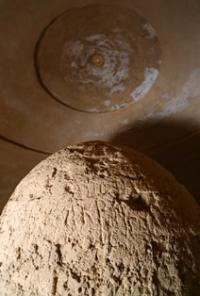You are here
Fayaz-Tepa complex.



Excursions on monuments of Termez.
“There is no place for wandering in the world
peoples, besides their all means
try to lead to a settled life,
so in this respect the moment when
"The wheel will stop spinning" is not too
is far away. So by the end of the cycle
Cain truly finishes killing Abel. ”
R. Guenon "The Kingdom of Quantities and Signs of Time".
Weekend tours in Termez.
From ancient times the territory of Central Asia has been a crossing point not only of many caravan roads and ways, but also a place where different religions coexisted in ancient times: Zoroastrianism, Buddhism, Manichaeism.
Buddhist temple and monastery complex - 1 km to the northwest of the ancient settlement of Old Termez. I built a century, has the shape of an elongated rectangle 117 X 34 m, oriented northwest - southeast. Consists of a temple, monastery, refectory and a detached mortar.
The central part of the complex is a temple with a square yard and 19 th on the perimeter of the premises. Along the walls of the courtyard with the remains of murals is sufa, roofed multicolumn aivan. In the southwestern side of the courtyard - a sanctuary.
At the entrance he remained head of the Buddha in a halo. To her right adjacent to a small figure standing Buddhas, monks, and laity, on the left - the shape of local deities, going to the Buddha. In the sanctuary to the left of the entrance depicts two life-size standing figures of Buddha, and smaller figures of women.
n the opposite wall - daronostsy in Kushan dress. On the floor, many pieces of gypsum and clay sculptures and bas-relief limestone seated Buddha and two monks. The monastery complex includes part of the yard with aivan and 13 rooms.
From the southeast to the church adjoined the refectory, which consisted of the same court and 13 rooms. Some of them are preserved hearths for cooking, a large number of potsherds with inscriptions Kharoshti, Brahmi, Bactrian and "unknown letter."
Coins found on the floor in imitation Chekanu Heliocles, Vima Kadfiz, nameless king, Kanishka, and in ruins - Huvishka and Vasudeva. In the northeast, outside the temple is a large stupa with a cruciform base, in which the body entombed small, round in terms of a stupa (E.3. B.2, 8 m), dating from the I century BC The complex is supplied with water from the Amu Darya River by plumbing length of 2.5 km. (Mound aqueducts usually defined as the northern city wall of the Kushan).
In the IV century the complex was plundered the Sassanid army (the coin of Shapur I, Hormizd I) and subsequently ceased to exist. In the V - VI century early part of its premises used for burials (coins Hormizd II and imitation coins Perosa).
By the beginning of IX century ruins of the temple-monastery complex acquired form of the hill, where was the treasure of silver and Umayyad Abbasid dirhams. At present, several Buddhist temples survived in Uzbekistan. Among the most famous are Airatam, Kara-Tepa and Fayaz-Tepa. Fayaz-Tepa complex was discovered in 1963 by the archaeologist L. Albaum during excavations near the Buddhist temple on the Kara-Tepa hill in the heart of the old Termez.
This temple complex is characterized by rich paintings and well-preserved sculptures. The complex is U-shaped series of corridors, cells and sanctuaries. Separately, there is a Buddhist dagoba, which is also of great interest.
The building itself can be divided into three parts. One part is accommodation and ancillary buildings. Another one was the original dining room with kitchen, and a third one was used for performance of religious rites. Fayaz-Tepa is not only an iconic monument of Buddhism in Central Asia, but also of great value as one of the few monuments of Buddhist pictural art, which adorns the walls of the complex.
The walls along the temple were covered with paintings depicting the Buddha image variations. The walls of the sanctuary were decorated with images and story lines, one of which is the image of the two Buddhas, with images of women on both sides.
The fact that the image of Buddha in Fayaz-Tepa is considered one of the most ancient images to have survived to the present date, and dates back to Ist century BC is of special importance.
The sculptures discovered by archaeologists in Fayaz-Tepa are also noteworthy. In particular, this is the statue of Buddha sitting under the sacred bodhi tree, and two monks standing on both hands.
All this is included in the arch, resting on Corinthian columns. The sculpture was carved from limestone and covered with gold leaf. Today, this sculpture is one of the most valuable exhibits of the State Museum of History of Uzbekistan.
A giant dagoba of 10 meters high was discovered near the temple. There is a small dagoba inside of it of 3 meters high. This finding dates back to the Ist century AD. In the IIIrd century BC Termez was invaded by the Sassanid army, resulting in destruction of many Buddhist temples, including Fayaz-Tepa.
At the time of archaeological excavations the building was heavily damaged and was under a huge layer of sand and dust. Today Fayaz-Tepa hosts a museum, research and restorations are underway.
Authority:
«The Guidebook on historical and cultural places of interest of the Surkhan-Darya area and the city of Termez». 2011.
Photos:
Alexander Petrov.






